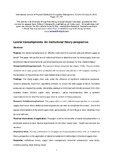- CERES Home
- →
- School of Management (SoM)
- →
- Staff publications (SoM)
- →
- View Item
JavaScript is disabled for your browser. Some features of this site may not work without it.
| dc.contributor.author | Stanger, S. H. W. | - |
| dc.contributor.author | Wilding, Richard D. | |
| dc.contributor.author | Hartmann, E. | |
| dc.contributor.author | Yates, Nicola | |
| dc.contributor.author | Cotton, S. | |
| dc.date.accessioned | 2014-05-01T04:00:54Z | |
| dc.date.available | 2014-05-01T04:00:54Z | |
| dc.date.issued | 2013-10-04T00:00:00Z | - |
| dc.identifier.citation | Sebastian H.W. Stanger, Richard Wilding, Evi Hartmann, Nicola Yates, Sue Cotton, Lateral transshipments: an institutional theory perspective, International Journal of Physical Distribution & Logistics Management, Volume 43, Issue 9, 2013, Pages 747-767 | |
| dc.identifier.issn | 0960-0035 | - |
| dc.identifier.uri | http://dx.doi.org/10.1108/IJPDLM-09-2011-0155 | - |
| dc.identifier.uri | http://dspace.lib.cranfield.ac.uk/handle/1826/8416 | |
| dc.description.abstract | Purpose: Are lateral transshipments an effective instrument to ensure the safe and efficient supply of blood? This paper will use the lens of institutional theory to determine how the blood supply chain can benefit from lateral transshipments and what requirements are necessary for their implementation. Design/methodology/approach: The research design comprises two stages. Firstly, 16 case studies clustered into 2 case groups were conducted with transfusion laboratories in UK hospitals resulting in the derivation of 8 key themes which were tested using a follow up survey. Findings: The blood supply chain acts under the influence of significant institutional pressures. Coercive pressures result from regulations enforced to ensure the safe supply of blood, normative pressures are imposed by society, demanding wastage is minimized and mimetic pressure from other hospitals fosters efficient supply chain operation. Lateral transshipments offer a powerful organizational tool to allow the blood supply chain to conform to these pressures. Research limitations/implications: This paper offers a novel institutional perspective on a complex supply chain issue where additional external pressures are seen to complicate the context. Due to the special characteristics of the blood supply chain, generalization of the findings to other industries must be done with care. Practical implications (if applicable): The paper confirms the benefits of lateral transshipments in a perishable product context. Special requirements for the blood supply chain / health care services are identified. Originality/value: The key contributions of this paper are five propositions which offer an institutional theory perspective on the application of lateral transshipment relationships in the blood supply chain. | en_UK |
| dc.language.iso | en_UK | - |
| dc.publisher | Emerald Group Publishing Limited | en_UK |
| dc.title | Lateral Transshipments: An Institutional Theory Perspective | en_UK |
| dc.type | Article | - |
Files in this item
This item appears in the following Collection(s)
-
Staff publications (SoM) [1260]
